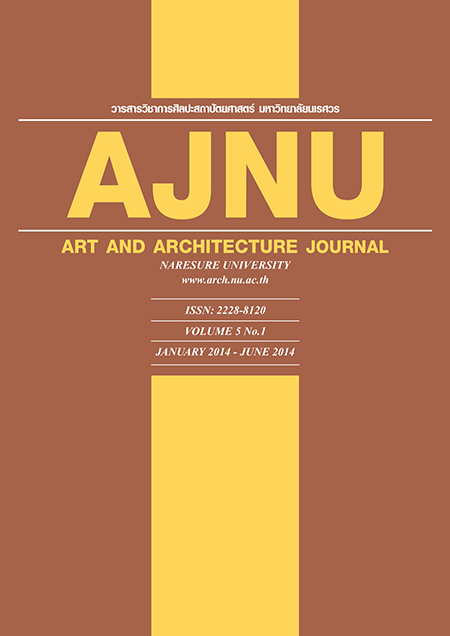การศึกษาและพัฒนากระบวนการใช้ประโยชน์จากเศษหนังเหลือทิ้ง กลุ่มวิสาหกิจขนาดกลาง และขนาดย่อม (SMEs)
Main Article Content
บทคัดย่อ
งานวิจัยพบว่า กลุ่มวิสาหกิจขนาดกลาง และขนาดย่อม (SMEs) วิสาหกิจชุมชนกระเป๋าหนังต่อ มีการทิ้งเศษหนังเหลือ ทิ้งจากกระบวนการอุตสาหกรรมไปโดยเสียเปล่า 30-40 กิโลกรัม/เดือน วิสาหกิจชุมชนกระเป๋าหนังวัว ทิ้งเศษหนังเหลือทิ้ง 60- 80 กิโลกรัม/เดือน วิสาหกิจชุมชนกระเป๋าหนังปลากระเบน ทิ้งเศษหนังเหลือทิ้ง 10-20 กิโลกรัม/เดือน ซึ่งแบ่งประเภทของเศษ หนังเหลือทิ้งได้เป็น 1) เศษหนังเหลือทิ้งจากการตัดเย็บ 2) เศษหนังเหลือทิ้งจากการปั้มหนังด้วยเครื่องไฮโดรลิค 3) เศษหนัง เหลือทิ้งจากรอยตำหนิบนแผ่นหนัง พบว่า กลุ่มวิสาหกิจขนาดกลาง และขนาดย่อม (SMEs) ไม่ได้ใช้ประโยชน์จากเศษวัสดุ ผู้วิจัย จึงนำ กระบวนการติดกาวแผ่นหนัง (Cementing Leather) และ กระบวนการเย็บหนัง (Sewing Leather) มาประยุกต์ใช้เศษ หนังเหลือทิ้งจากกระบวนการกลับมาสู่กระบวนการผลิตอีกครั้ง เพื่อพัฒนาเป็นผลิตภัณฑ์ที่มีความคุ้มค่าทางเศรษฐกิจ ด้าน กระบวนการติดกาวแผ่นหนัง พบว่า กาวขาว มีความเหมาะสมที่สุดในการนำมาประยุกต์ใช้ในกระบวนการติดกาวแผ่นหนัง (Cementing Leather) ด้านกระบวนการเย็บหนัง พบว่า รูปแบบการเย็บเฉพาะส่วนสองด้าน มีความเหมาะสมที่สุดในการนำมา ประยุกต์ใช้สำหรับกระบวนการเย็บเศษหนังเหลือทิ้ง จากผลประเมินการพัฒนาผลิตภัณฑ์โดยการประยุกต์ใช้ประโยชน์จากเศษ หนังเหลือทิ้ง ของของกลุ่มวิสาหกิจขนาดกลาง และขนาดย่อม (SMEs) พบว่า ผลิตภัณฑ์กระเป๋ามีความเหมาะสมมากที่สุดในการ ประยุกต์ใช้กระบวนการใช้ประโยชน์จากเศษหนังเหลือทิ้ง โดยผู้วิจัยได้นำแนวคิดการออกแบบที่สืบเนื่องจากธรรมชาติ มา ออกแบบชุดกระเป๋าโดยอิงรูปทรงธรรมชาติจากปลาปักเป้า และใช้ทฤษฎีการกระจายหน้าที่เชิงคุณภาพ วิศวกรรมย้อนรอยใน การคัดเลือกรูปแบบกระเป๋าที่มีความเหมาะสมทั้งสิ้น 5 รูปแบบ เพื่อการประเมินแบบโดยผู้ทรงคุณวุฒิและผู้เชี่ยวชาญ ซึ่งความ คิดเห็นต่อผู้ทรงคุณวุฒิและผู้เชี่ยวชาญที่มีต่อผลิตภัณฑ์ชุดกระเป๋าจากเศษหนังเหลือทิ้ง ทั้ง 5 รูปแบบ โดยรวม พบว่า ผู้ทรงคุณวุฒิและผู้เชี่ยวชาญมีความเห็นสอดคล้องกันว่า ผลิตภัณฑ์ชุดกระเป๋าจากเศษหนังเหลือทิ้ง รูปแบบที่ 2 กระกอบไปด้วย กระเป๋าหูหิ้ว, กระเป๋าสะพายข้าง และกระเป๋าถือ อิงการออกแบบจากรูปทรงปลาปักเป้าสกุล Dicotylichthys มีความเหมาะสม มากที่สุด
STUDY AND DEVELOPMENT PROCESS FOR SMALL AND MEDIUM ENTERPRISE FROM LEATHER WASTE USAGE
The research found groups of bags(handbag) industries, Small and Medium Enterprise (SMEs) of leather bag haves craps waste from process of industrial by 30-40 kg/month. Small and Medium Enterprise of leathers handbag from cow disposed the waste of leather around 60-80 kg/month. Small and Medium Enterprise of leathers handbag from stingray have disposed the waste leather 10-20 kg/month, which can classify the waste of leather scraps as follows; 1. Leather scraps from the sewing(cutting) 2. Leather scraps from the pumps process with hydrochloric machine 3. Leather scraps from the defect on the leather. We found the Small and Medium Enterprise of leathers don’t use these scraps, so the researcher take the process cementing leather and sewing leather applied with the leather scraps from the waste back to the production process again, to develop a product with an economic value.The process of gluing adhesive leather, found that white glue is most appropriate to applied with the process of cementing leather. The process of sewing patterns(sewing leather), found that pattern sewing on two sides are the best suitable for applied with the sewing(specific parts) waste leather process. From the evaluation of developing product by implement the waste of leather from small groups of handbag industries, found bags/handbags product are most suitable applied to used the utilization from these waste leathers. Researchers had used the design as the natural concepts to design bags based on natural shape of Puffer fish and used the distribution quality function theory reverse engineering for select styles of appropriate handbags to 5 styles, for evaluated patterns by the professionals. The overall, we found experts and professionals have the same opinions about products of leather bags style 2 that used the design reference from shape of Puffer fish (family Dicotylichthys) which is the most appropriate.Article Details
ประเภทบทความ
บทความวิจัย


